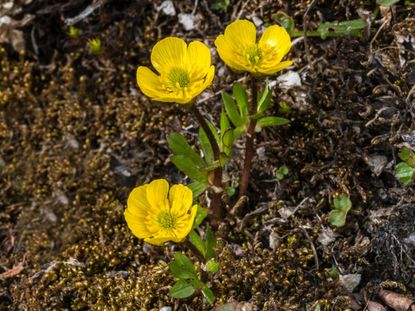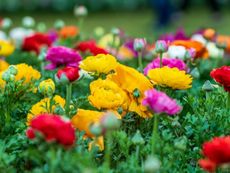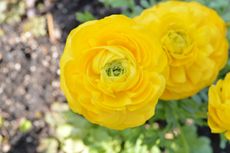Buttercups For The Garden - Growing Info And Care of Ranunculus Buttercup Plants
Ranunculus buttercup plants produce cheery little multi-petaled flowers. Some people love them but they are invasive and many consider them weeds.


QUICK FACTS:
Botanical name - Ranunculus bulbosus, Ranunculus sardous
Height: Up to 24 in. (61 cm.)
Spread: Up to 10 in. (25 cm.)
Sun exposure: Full Sun
Soil requirements: Moist loam, slightly acidic
Hardiness zones: USDA zones 3-8
Gardening tips, videos, info and more delivered right to your inbox!
Sign up for the Gardening Know How newsletter today and receive a free download of our most popular eBook "How to Grow Delicious Tomatoes."
When to plant: Not advised, invasive species
RANUNCULUS BULBS: GROWING RANUNCULUS BUTTERCUP FLOWERS in THE GARDEN
With over 1,000 species of plants, the Ranunculus genus is extremely diverse. While many ranunculus plants are welcome additions to the flower garden, others may be much more problematic. Common buttercup flowers are one example of this. Below, we will discuss buttercup plants in greater detail, as well as ways to better control their aggressive spread.
Both Ranunculus bulbosus and Ranunuclus sardous are considered invasive species. The plants have naturalized throughout much of the United States, having quickly filled gaps in home landscapes, lawns, and along roadsides. Because of their small size, buttercup plants often go unnoticed until they begin to bloom. However, careful observers may first identify the plants by their large masses of mounded foliage, and uniquely shaped leaves. Once in bloom, both species will produce numerous small yellow flowers. Though the cup-like blooms are quite small, each plant is able to turn out a multitude of mature seeds.
How Buttercup Flowers Multiply
Common buttercups are considered to be short-lived perennials. After their flowers have dropped their seed in the fall, germination begins quickly as small seedlings overwinter until spring. This long period of establishing themselves allows for the development of a robust root system. Established plants may die back in the autumn, but underground corms ensure that they are able to overwinter in the ground, allowing for these specimens to resume growth when the weather begins to warm.
Within a very short period of time, buttercups multiply and grow to form thick matted tangles. Troublesome to gardeners, these dense formations often outcompete native species and other crops.
Note: This ranunculus species is toxic, therefore, caution should be used. Buttercups have shown to be extremely harmful to people, as well as livestock. Simple exposure to the plant can cause both rash and blistering of skin. Fortunately, there are several ways you may be able to control or reduce the occurrence of buttercups.
How To Control Buttercups
Many landscapers successfully control buttercups simply through the application of soil amendments. Since these invasives prefer soil with very low fertility, working and fertilizing garden beds can be quite helpful in eliminating this nuisance plant. These species of ranunculus can also be removed mechanically, as any other garden weed. Your best chance of success is removing the plants while they are still quite small.
Proper safety equipment, such as gloves and eye protection are required when handling these plant materials. Established groups of buttercups may require the use of chemical herbicides. This is most common when treating large lawns, pastures, and sport fields. Remember, before you apply any herbicide, it’s essential to carefully read the manufacturer’s label for safe use.
Note: Any recommendations pertaining to the use of chemicals are for informational purposes only. Chemical control should only be used as a last resort, as organic approaches are safer and more environmentally friendly.

Tonya Barnett has been gardening for 13 years. Flowers are her passion. She has trasformed her backyard into a cut flower garden, which she regularly chronicles on her YouTube channel http://www.youtube.com/@tonyawiththeflowers.
-
 Urban Beekeeping Guide: Top Tips For Raising Bees In The City
Urban Beekeeping Guide: Top Tips For Raising Bees In The CityUrban beekeeping can be a rewarding and appreciated pastime, but first be sure it’s legal in your city and learn the ropes of beekeeping.
By Mary Ellen Ellis
-
 2024 Plant Of The Year: Why Experts Say Philodendron Is The “It” Plant Of The Year
2024 Plant Of The Year: Why Experts Say Philodendron Is The “It” Plant Of The YearWe aren’t surprised that philodendron was designated the plant of the year. Versatile, easy-care and lovely, it’s the houseplant of the year 2024!
By Bonnie L. Grant
-
 Ranunculus Varieties To Try
Ranunculus Varieties To TryFlower beds filled with ranunculus are truly a sight to behold when planted en masse. Read on for some of our favorite varieties.
By Tonya Barnett
-
 Propagating Persian Buttercups: How To Propagate Persian Buttercup Plants
Propagating Persian Buttercups: How To Propagate Persian Buttercup PlantsGrowing from both seeds and tubers, Persian buttercup propagation is not complicated. If you desire to grow this frilly specimen in your landscape, click here to learn how to propagate Persian buttercup, Ranunculus, and which method is best for you.
By Becca Badgett
-
 Storing Ranunculus: When And How To Store Ranunculus Bulbs
Storing Ranunculus: When And How To Store Ranunculus BulbsGlorious ranunculus makes a delicious display in groupings or simply in containers. The tubers are not hardy in zones below United States Department of Agriculture zones 8, but you can lift them and save them for the next season. This article will help.
By Bonnie L. Grant